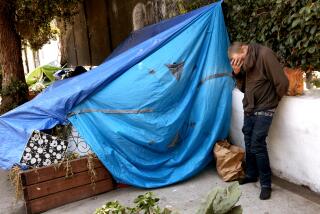A colorful piece of Venice history
In a part of town where century-old cottages are routinely razed and replaced, Mark Ryavec’s Venice relic is standing firm.
Built about 1907, the bright yellow house with blue-green trim is just a few years younger than the home considered the oldest in Venice, built by Venice developer Abbot Kinney in 1904.
Like the Kinney house, Ryavec’s two-story dwelling has qualities of an Islamic style, characterized by domes on a flat roof, wide eaves, lavish moldings inside and out and interior niches that bring to mind the prayer alcoves found in mosques.
Ryavec’s home also has a sunroom/sleeping porch built in the Craftsman style that was just coming into vogue in Venice at the time.
“Someone had a lot of fun with this house,” said Ryavec, 53, a lobbyist. Who that person was remains a mystery. No documentation names the builder.
Ryavec bought the four-bedroom, 2,300-square-foot house -- and the two rental units behind it -- in 1989 for $515,000 and has been restoring it ever since.
Two previous owners made considerable improvements, including remodeling the kitchen. Owners before that also made changes, such as enclosing the original porches.
Like many owners of altered older homes, Ryavec faced some difficult choices in the process: Retain changes made by previous owners so long ago that they now have historical significance of their own, or undo those changes and restore the home to its original look?
In 1989, the house was painted a color Ryavec calls “green mud” and trimmed with a dark pink color suggesting a Queen Anne motif. Neither the house nor its neighborhood was in good condition, but as Ryavec was working to restore the home, the neighborhood was improving as well.
In bringing the home’s exterior details back to their original state, Ryavec relied on a sepia-toned photo of the house taken about 1915 that he received with his home purchase. The photo shows the two open porches, ornate fascia and window moldings and elaborate railings around balconies. It also shows hitching posts for horses and an adjacent dirt road.
Ryavec’s main goals for the exterior were to restore as much of the moldings and fascia as possible and to paint the house in its original colors. He had moldings custom-milled to match the original geometric design and discovered the original colors by scratching down to the first layer of paint on the exterior stucco and wood.
“It’s like an archaeological dig,” he said. To accomplish the job, he hired a painter full time for six months, and then every Saturday thereafter.
Inside, he had the fir wood floors and stairs refinished, and the living room replastered. One of the living room’s alcoves, along with the alcove’s window, had been lined with brick and used to house a wood-burning stove. To return the alcove to its original condition, Ryavec used a small jackhammer to demolish the brick. The job took a toll on his body, he said.
Perhaps the most time-consuming job has been restoring the home’s multi-paned windows. Ryavec takes each window apart, strips off the paint, restores or replaces rotted frames and mullions, replaces broken panes with old or restoration glass and puts them back together.
“It’s very meditative, redoing windows,” he said. “Something you do on a rainy night.”
After working on a few windows, though, Ryavec decided that stripping paint was best hired out to a professional. “Once you do some stripping,” he said, “you realize you want someone else to do it.”
In the end, Ryavec decided not to restore the two enclosed porches to their original open state. He enjoys the added square footage they bring to the interior, as well as the beveled and stained-glass windows that match the spirit of the house, if not the era.
Ryavec hopes to be finished with his restorations by 2007, in time to mark the home’s centennial. He estimates that he has already spent $100,000 on improvements, including copper plumbing, electrical work and a renovated bathroom and has put in a few hundred to 1,400 hours of his own labor annually.
He still has more windows to refurbish, including the lattice on the windows of the two upstairs turrets, a feature evident in the 1915 photograph. He also hopes to replace more fascia moldings as well as the geometrically fashioned balcony railings that were lost over time.
Meanwhile, the striking house, set on a prominent corner in his Venice neighborhood, adds to the area’s character.
Not everyone appreciates the home’s historical significance, though. Ryavec recalled the day that a passerby on a bicycle observed the brightly colored house and called out: “When are you going to open Disneyland?”
*
(BEGIN TEXT OF INFOBOX)
Source book
* Plastering: Charles V. Scira, No Show Patch Plastering, Century City, (310) 559-5801
* Wood trim milling: Tom Vukelic, carpenter, Los Angeles, (310) 346-9613
* Wood stripping: Mike Miller, Stripper Herk Furniture Stripping, Santa Monica, (310) 399-8112
-- Kathy Price-Robinson
*
Kathy Price-Robinson is a freelance writer who has written about remodeling for 14 years. If you would like to have your remodel considered for use in Pardon Our Dust, please send before and after images and a brief description of the project to [email protected] or mail them to Real Estate Editor, Los Angeles Times, 202 W. 1st St., Los Angeles, CA 90012.
More to Read
Sign up for Essential California
The most important California stories and recommendations in your inbox every morning.
You may occasionally receive promotional content from the Los Angeles Times.






